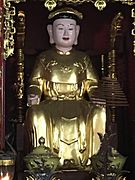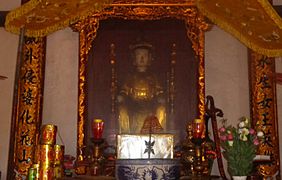Lady Triệu facts for kids
Quick facts for kids
Lady Trieu
|
|
|---|---|

Folk art depiction of Lady Trieu
|
|
| Native name | |
| Born | c. 226 Yên Định District, Jiuzhen, Jiaozhou |
| Died | c. 248 (aged c. 22) Hậu Lộc District, Jiuzhen, Jiaozhou |
| Buried |
Tùng mountain (Triệu Lộc Commune, Hậu Lộc District, nowaday Thanh Hóa province)
|
| Lady Trieu | |
|---|---|
| Lady Trieu | |
| Vietnamese name | |
| Vietnamese | Bà Triệu; Triệu Ẩu |
| Hán-Nôm | 趙嫗 |
Lady Triệu (Vietnamese: Bà Triệu, Chữ Hán: 趙嫗 Triệu Ẩu; c. 226–248 AD) was a warrior in 3rd century Vietnam who managed, for a time, to resist the rule of the Chinese Eastern Wu dynasty. She is also called Triệu Thị Trinh, although her actual given name is unknown. She is quoted as saying, "I'd like to ride storms, kill orcas in the open sea, drive out the aggressors, reconquer the country, undo the ties of serfdom, and never bend my back to be the concubine of whatever man."
Contents
Background
In 226, Sun Quan sent 3,000 troops to reassert direct Chinese control over Jiaozhi and also to eradicate the Shi Xie family. Sun Quan's forces captured and executed Shi Hui along with all of his family, then stormed Jiuzhen and killed ten thousand people, along with surviving members of Shi Xie's family. Sun Quan divided Jiaozhi into two separated provinces, Jiaozhou and Guangzhou. In 231, Eastern Wu again sent a general to Jiuzhen to "exterminate and pacify the barbarous Yue tribes."
Biography
In 248, the people of Jiaozhi and Jiuzhen districts of Jiaozhou province rebelled against the Wu Chinese. A local woman named Triệu Ẩu in Jiuzhen led the rebellion, followed by a hundred chieftains led fifty thousand families in her revolt. Eastern Wu sent Lu Yin to deal with the rebels, and put Lady Trieu to death after several months of warfare. Although Chinese records did not mention lady Trieu, she was described by Le Tac, a 13th-century Vietnamese scholar exiled in Yuan China in his Annan zhilue as a woman who fought on an elephant in battle. K. W. Taylor argued that "the resistance of Lady Trieu was for them (Chinese) simply a kind of stubborn barbarism that was wiped out as a matter of course and was of no historical interest." Catherine Churchman (2016) indicates that Taylor is mistaken. According to her, the oldest and also most detailed record of Lady Trieu came from Jiaozhou ji of Liu Xinqi, and was quoted in the Taiping Yulan (c. 980).
Chin intervention
In 263, Lu Hung (呂興), a prefecture in Jiaozhou, gained supports from local people and soldiers, murdered Wu administrators Sun Hsu (孫諝) and Teng Hsun (鄧荀), then sent envoys to Cao Wei requesting military assistance. Jiaozhi, Jiuzhen and Rinan were transferred to Wei. In 265, Jin dynasty (266–420) replaced Cao Wei, immediately sent Yang Chi to annex Jiaozhou with local supports. In 268, Wu sent two generals, Liu Chun and Hsiu Tse to reconquer Jiaozhou, but were repelled by Jin armies. In 270 Jin and Wu armies clashed in Hepu. The Wu general, Tao Huang contacted with Luong Ky, a local commander collaborating with the Jin and convinced him to side with the Wu, enabled the Wu army to recapture Jiaozhi’s ports and main towns in 271. Fighting continued in the countryside until 280, when Jin destroyed Wu, reunifying China.
Vietnamese account
Traditional
Đại Việt sử ký toàn thư (大越史記全書 Complete annals of Great Viet), written during the Lê dynasty, said the following about Lady Trieu:
The Mậu Thìn year, [248], (11th year of Emperor Diên Hy of Han (Han Yanxi 漢延熙); 11th year of Xích Ô (Chiwu 赤烏)). The people of Cửu Chân (Jiuzhen 九真) again attacked citadels, the prefecture was in rebellion. The Wu king appointed the Hành Dương Imperial Secretist Lục Dận [Lu Yin] (sone source said Lục Thương [Lu Shang]) to Inspectorship of Jiaozhou. Dận arrived, used the people's respect for him to call them to lay down arms, people surrendered, numbering more than 30,000 households, and the prefecture was once again peaceful. Afterwards, a woman from the Cửu Chân commandery named Triệu Ẩu assembled people and attacked several commanderies. Dận was able to subdue [her]. (Giao Chỉ records only write: In the mountains of Cửu Chân commandery there was a young woman surnamed Triệu,..., unmarried, assembled people and robbed the commanderies, often wore gilded coarse tunics and toothed footwears (or toothed footwears made from gilded coarse clothes?), and fought while sitting on an elephant's head, after she died she became an immortal).
Modern
Việt Nam sử lược (A Brief history of Vietnam), a history book that was written in the early 20th century by Vietnamese historian Trần Trọng Kim, said the following about Lady Trieu:
In this year on Cửu Chân prefecture, there was a woman named Triệu Thị Chinh who organized a revolt against the Ngô [Wu].
Our [Vietnamese] history recorded that lady Trieu was a people of Nông Cống district. Her parents were dead all when she was a child, she lived with her older brother Trieu Quoc Dat. At the age of 20, while she was living with her sister-in-law who was a cruel woman, she [Trieu Thi Trinh] killed her sister[-in-law] and went to the mountain. She was a strong, brave and smart person. On the mountain, she gathered a band of 1.000 followers. Her brother tried to persuade her from rebelling, she told him: "I only want to ride the wind and walk the waves, slay the big whales of the Eastern sea, clean up frontiers, and save the people from drowning. Why should I imitate others, bow my head, stoop over and be a slave? Why resign myself to menial housework?".
The Mậu Thìn year, [248], because of the cruelty of Ngô [Wu] mandarins and misery of people, Trieu Quoc Dang revolted in Cửu Chân prefecture. Lady Trieu led her troops joined her brother's rebellion, soldiers of Trieu Quoc Dat made her leader because of her braveness. When she went to battles, she usually wore yellow tunics and rode a war-elephant. She proclaimed herself Nhụy Kiều Tướng quân (The Lady General clad in Golden Robe).
Giao Châu Inspector Lục Dận sent troops to fight [her], she [Trieu Thi Trinh] had managed to fight back the Ngô [Wu] forces for 5 or 6 months. Because of the lack of troops and fighting alone, she [Trieu Thi Trinh] could not manage to fight a long war and was defeated. She fled to Bồ Điền commune (present-day Phú Điền commune, Mỹ Hóa district) and then took her own life.
Later, the Nam Đế (Southern Emperor) of Early Lý dynasty praised her as a brave and loyal person and ordered [his followers] build her a temple, and gave her the title of "Bật chính anh hùng tài trinh nhất phu nhân" (Most Noble, Heroic and Virgin Lady). Present day in Phú Điền commune, in the Thanh Hóa province there is a temple [for her].
Other accounts
The earliest mention of Trieu Thi Trinh can be found in the "Jiaozhou Ji"(交州记) written in the Jin dynasty, and collected in the Taiping Yulan . In the book Vietnamese Tradition on Trial, 1920-1945 written by David G. Marr, an American Professor, told the story of Trieu Thi Trinh as follow: Trieu Thi Trinh was a 9-foot-tall (2.7 m) woman who ... had a voice which sounded like a temple bell, and she could eat many rice pecks and walk 500 leagues per day. Moreover, Trinh had a beauty that could shake any man's soul. Because of repeated altercations, she killed her sister-in-law and went to a forest in which she gathered a small army and attacked the Chinese. When her brother tried to persuade her from rebelling, she told him:
I only want to ride the wind and walk the waves, slay the big whales of the Eastern sea, clean up frontiers, and save the people from drowning. Why should I imitate others, bow my head, stoop over and be a slave? Why resign myself to menial housework?
After hearing Trinh's words, her brother decided to join her. At first the Chinese underestimated Trinh for her being a female leader but after some encounters, they feared her because of her gaze. Three centuries later, she still offered spiritual support for male Vietnamese opponents of the Chinese. During the 11th century she was honored by the Ly court with a lot of posthumous titles. During the Lê dynasty, Neo-Confucianism became Vietnam's national ideology and many scholars aggressively tried to bring the practices of Trieu Thi Trinh into conformity with Neo-Confucianism. Nevertheless, she survived all their manipulations.
Historical differences
Most available information comes solely from Vietnamese sources that were written during or after the late Ming dynasty. However, the Sanguozhi (Records of the Three Kingdoms), a classical Chinese historical account, does mention a rebellion at this time in the commanderies of Jiaozhi (交趾; Vietnamese: Giao Chỉ) and Jiuzhen (九真, Vietnamese: Cửu Chân):
In the 11th year of Chiwu (赤烏) [248] in Jiaozhi (交趾), Jiuzhen (九真) rebels attacked walled cities which caused a great uproar. Lu Yin (陸胤) [of Hengyang (衡陽)] was given rank of the Inspector of Jiaozhou by the Sovereign of Wu. He took his troops and entered the southern border and sent word to the rebels. He used his craftiness to convince them to accept his terms. [In] Gaoliang (高涼), the commander Huang Wu (黄吳) with 3,000 households came out to surrender. Lu Yin now led the army south to that region. He announced his sincerity [to the aborigines] and distributed gifts. The [remaining] 100 rebel leaders and 50,000 households, who had been unruly and unapproachable, kowtowed [to Lu Yin]. Thus the territory was handed over peacefully. At once Lu Yin was given the rank of General who Tranquilizes the South. Again he was sent on a punitive expedition against the rebels in Cangwu (蒼梧). He defeated them quickly. From start to finish Lu Yin's military troops totaled 8,000. (Later commentaries also cited that Lu Yin then helped to plant crops and kept the people fed.)
Keith W. Taylor, an American professor, explained these differences as following:
Chinese records do not mention Lady Trieu; our knowledge of her comes only from Vietnamese sources. From this it is evident that the events of 248 were remembered differently by the two sides. The Chinese only recorded their success in buying off certain rebel leaders with bribes and promises. The resistance led by Lady Trieu was for them simply a kind of stubborn barbarism that was wiped out as a matter of course and was of no historical interest. On the other hand, the Vietnamese remembered Lady Trieu's uprising as the most important event of the time. Her leadership appealed to strong popular instincts. The traditional image of her as a remarkable yet human leader, going into battle astride an elephant, has been handed down from generation to generation. After Lady Trieu's death, her spirit was worshipped by the Vietnamese. We owe our knowledge of her to the fact that she was remembered by the people.
Legacy
Triệu Thị Trinh is a greatly celebrated hero and many streets are named after her in Vietnamese cities (there are Bà Triệu streets in Huế, Hà Nội, Ho Chi Minh City, and several other cities).
-
View from outside of the gate of Bà Triệu Temple in Hậu Lộc District, Thanh Hóa Province
See also
 In Spanish: Lady Triệu para niños
In Spanish: Lady Triệu para niños




